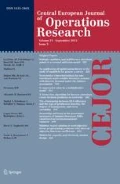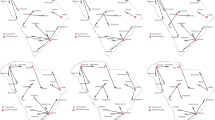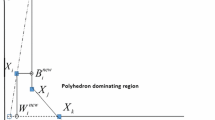Abstract
The problem of ranking efficient decision making units (DMUs) is of interest from both theoretical and practical points of view. In this paper, we propose an integrated data envelopment analysis and mixed integer non-linear programming (MINLP) model to find the most efficient DMU using a common set of weights. We linearize the MINLP model to an equivalent mixed integer linear programming (MILP) model by eliminating the non-linear constraints in which the products of variables are incorporated. The formulated MILP model is simpler and computationally more efficient. In addition, we introduce a model for finding the value of epsilon, since the improper choice of the non-Archimedean epsilon may result in infeasible conditions. We use a real-life facility layout problem to demonstrate the applicability and exhibit the efficacy of the proposed model.


Similar content being viewed by others
References
Adler N, Friedman L, Stern ZS (2002) Review of ranking methods in data envelopment analysis context. Eur J Oper Res 140:249–265
Amin GR (2009) Comments on finding the most efficient DMUs in DEA: an improved integrated model. Comput Ind Eng 56(4):1701–1702
Amin GR, Toloo M (2004) A polynomial-time algorithm for finding epsilon in DEA models. Comput Oper Res 31(5):803–805
Amin GR, Toloo M (2007) Finding the most efficient DMUs in DEA: an improved integrated model. Comput Ind Eng 52(2):71–77
Amin GR, Toloo M, Sohrabi B (2006) An improved MCDM DEA model for technology selection. Int J Prod Res 44(13):2681–2686
Andersen P, Petersen NC (1993) A procedure for ranking efficient units in data envelopment analysis. Manag Sci 39(10):1261–1264
Anvari A, Zulkifli N, Sorooshian S, Boyerhassani O (2014) An integrated design methodology based on the use of group AHP–DEA approach for measuring lean tools efficiency with undesirable output. Int J Adv Manuf Technol 70(9):2169–2186
Azar A, Zarei Mahmoudabadi M, Emrouznejad A (2015) A new fuzzy additive model for determining the common set of weights in data envelopment analysis. J Intell Fuzzy Syst 30(1):61–69
Cook WD, Kress M, Seiford LM (1996) Data envelopment analysis in the presence of both quantitative and qualitative factors. J Oper Res Soc 47(7):945–953
Cooper WW, Seiford LM, Tone K (2007) Introduction to data envelopment analysis and its uses with DEA-solver software and references, 2nd edn. Springer, New York
Doyle J, Green R (1994) Efficiency and cross efficiency in DEA: derivations, meanings and uses. J Oper Res Soc 45(5):567–578
Ebrahimnejad A, Tavana M, Santos-Arteaga FJ (2016) An integrated data envelopment analysis and simulation method for group consensus ranking. Math Comput Simul 119:1–17
Ertay T, Ruan D, Tuzkaya UR (2006) Integrating data envelopment analysis and analytic hierarchy for the facility layout design in manufacturing systems. Inf Sci 176:237–262
Foroughi AA (2011) A new mixed integer linear model for selecting the best decision making units in data envelopment analysis. Comput Ind Eng 60:550–554
Foroughi AA (2013) A revised and generalized model with improved discrimination for finding most efficient DMUs in DEA. Appl Math Model 37(6):4067–4074
Lai PL, Potter A, Beynon M, Beresford A (2015) Evaluating the efficiency performance of airports using an integrated AHP/DEA-AR technique. Transp Policy 42:75–85
Lam KF (2015) In the determination of the most efficient decision making unit in data envelopment analysis. Comput Ind Eng 79:76–84
Li XB, Reeves GR (1999) A multiple criteria approach to data envelopment analysis. Eur J Oper Res 115:507–517
Pakkar MS (2015) An integrated approach based on DEA and AHP. Comput Manag Sci 12(1):153–169
Ramilan T, Scrimgeour F, Marsh D (2011) Analysis of environmental and economic efficiency using a farm population micro-simulation model. Math Comput Simul 81(7):1344–1352
Sexton TR, Silkman RH, Hogan AJ (1986) Data envelopment analysis: critique and extensions. In: Silkman RH (ed.) Measuring Efficiency: An Assessment of Data Envelopment Analysis, Jossey-Bass, San Francisco, pp. 73–105
Sun J, Wu J, Guo D (2013) Performance ranking of units considering ideal and anti-ideal DMU with common weights. Appl Math Model 37(9):6301–6310
Toloo M (2012) On finding the most BCC-efficient DMU: a new integrated MIP-DEA model. Appl Math Model 36:5515–5520
Toloo M (2014) The role of non-Archimedean epsilon in finding the most efficient unit: with an application of professional tennis players. Appl Math Model 38(21–22):5334–5346
Toloo M, Nalchigar S (2009) A new integrated DEA model for finding most BCC-efficient DMU. Appl Math Model 33:597–604
Wu J, Chu J, Zhu Q, Li Y, Liang L (2016) Determining common weights in data envelopment analysis based on the satisfaction degree. J Oper Res Soc 67(12):1446–1458
Yu P, Lee JH (2013) A hybrid approach using two-level SOM and combined AHP rating and AHP/DEA-AR method for selecting optimal promising emerging technology. Expert Syst Appl 40(1):300–314
Acknowledgements
The authors would like to thank the anonymous reviewers and the editor for their insightful comments and suggestions. This research was supported in part by the European Social Fund (CZ.1.07/2.3.00/20.0296) and the Czech Science Foundation (GAČR16-17810S).
Author information
Authors and Affiliations
Corresponding author
Rights and permissions
About this article
Cite this article
Toloo, M., Tavana, M. & Santos-Arteaga, F.J. An integrated data envelopment analysis and mixed integer non-linear programming model for linearizing the common set of weights. Cent Eur J Oper Res 27, 887–904 (2019). https://doi.org/10.1007/s10100-017-0510-y
Published:
Issue Date:
DOI: https://doi.org/10.1007/s10100-017-0510-y




